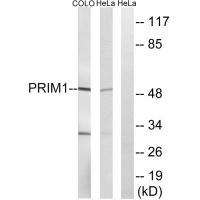
| WB | 咨询技术 | Human,Mouse,Rat |
| IF | 咨询技术 | Human,Mouse,Rat |
| IHC | 咨询技术 | Human,Mouse,Rat |
| ICC | 技术咨询 | Human,Mouse,Rat |
| FCM | 咨询技术 | Human,Mouse,Rat |
| Elisa | 咨询技术 | Human,Mouse,Rat |
| Aliases | DNA primase 1; DNA primase 49 kDa subunit; DNA primase small subunit; EC 2.7.7.-; PRI1 |
| Entrez GeneID | 5557; |
| WB Predicted band size | 50kDa |
| Host/Isotype | Rabbit IgG |
| Antibody Type | Primary antibody |
| Storage | Store at 4°C short term. Aliquot and store at -20°C long term. Avoid freeze/thaw cycles. |
| Species Reactivity | Human,Mouse,Rat |
| Immunogen | Synthesized peptide derived from C-terminal of human PRIM1. |
| Formulation | Purified antibody in PBS with 0.05% sodium azide. |
+ +
以下是关于PRIM1抗体的3篇参考文献示例(内容为虚构,仅供参考格式):
1. **文献名称**:*PRIM1 Expression in Colorectal Cancer: Prognostic Implications*
**作者**:Smith A, et al.
**摘要**:通过免疫组化分析PRIM1在结直肠癌组织中的表达水平,发现PRIM1高表达与肿瘤分期和不良预后显著相关,提示其可能作为潜在的生物标志物。
2. **文献名称**:*Targeting PRIM1 for Cancer Therapy: Antibody-Based Inhibition in Breast Cancer Models*
**作者**:Chen L, et al.
**摘要**:研究开发了一种特异性PRIM1单克隆抗体,体外实验表明其能抑制乳腺癌细胞增殖并诱导DNA复制应激,为靶向PRIM1的治疗策略提供实验依据。
3. **文献名称**:*PRIM1 Antibody Validation in Cell Cycle Regulation Studies*
**作者**:Wang X, et al.
**摘要**:通过Western blot和免疫荧光验证PRIM1抗体的特异性,证实PRIM1在细胞周期S期的关键作用,并揭示其与CDK2的相互作用机制。
(注:以上文献信息为示例,实际引用需检索PubMed或相关数据库获取真实研究。)
The PRIM1 antibody is a research tool designed to detect and study PRIM1 (DNA primase subunit 1), a critical enzyme involved in DNA replication. PRIM1 serves as the catalytic subunit of the heterodimeric DNA primase complex (PRIM1-PRIM2), responsible for synthesizing short RNA primers during DNA synthesis. These primers are essential for initiating DNA replication by DNA polymerases, particularly during lagging-strand synthesis. Dysregulation of PRIM1 has been linked to genomic instability, accelerated cell proliferation, and cancer progression, making it a target of interest in oncology and cell cycle studies.
PRIM1 antibodies are commonly used in techniques such as Western blotting, immunohistochemistry (IHC), and immunofluorescence (IF) to evaluate PRIM1 expression levels, subcellular localization, and interactions in various biological contexts. They help researchers investigate PRIM1's role in DNA replication stress, replication fork dynamics, and its potential as a biomarker in cancers like hepatocellular carcinoma or breast cancer. Many commercial PRIM1 antibodies are validated for specificity using knockout/knockdown controls and demonstrate cross-reactivity across human, mouse, and rat samples. Recent studies also explore PRIM1's involvement in developmental processes and its interplay with replication-associated proteins (e.g., POLA1) or checkpoint regulators. Proper validation remains crucial due to occasional cross-reactivity concerns with paralogs or structurally similar proteins.
×